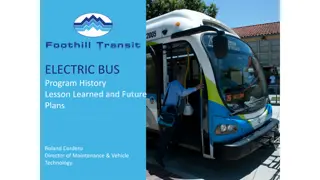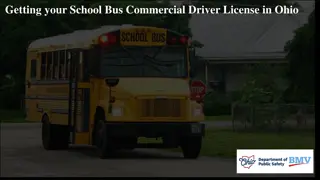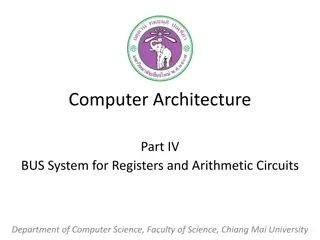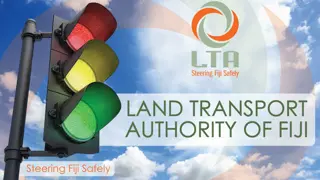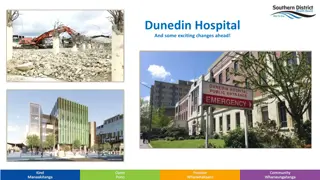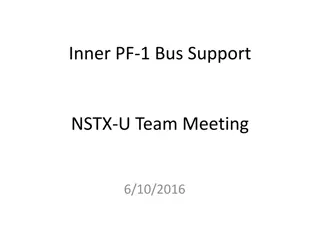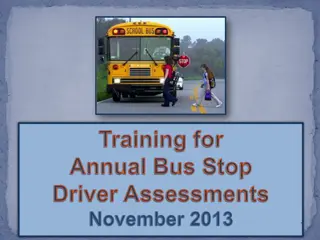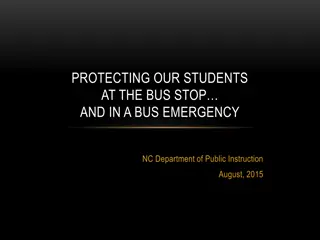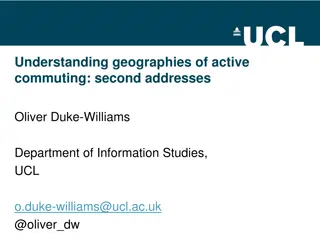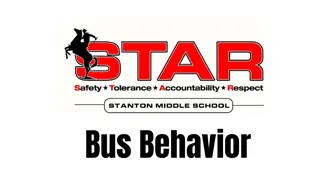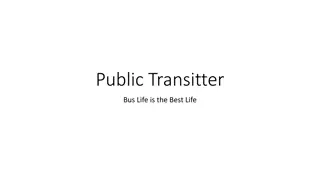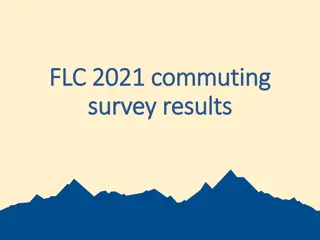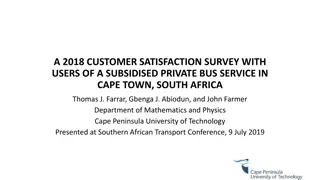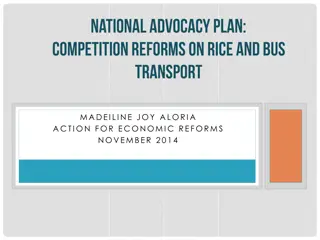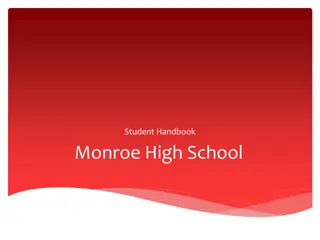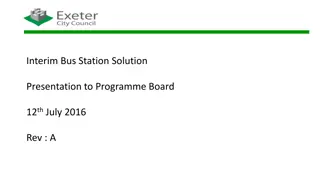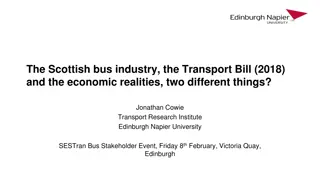Enhancing Public Bus Use for School Commuting in Dunedin
Explore policy recommendations to boost public bus utilization for school trips in Dunedin, New Zealand. Addressing low public transport usage among adolescents through environmental, policy, and personal factors evaluation.
Download Presentation

Please find below an Image/Link to download the presentation.
The content on the website is provided AS IS for your information and personal use only. It may not be sold, licensed, or shared on other websites without obtaining consent from the author.If you encounter any issues during the download, it is possible that the publisher has removed the file from their server.
You are allowed to download the files provided on this website for personal or commercial use, subject to the condition that they are used lawfully. All files are the property of their respective owners.
The content on the website is provided AS IS for your information and personal use only. It may not be sold, licensed, or shared on other websites without obtaining consent from the author.
E N D
Presentation Transcript
Policy Recommendations for Encouraging Public Bus Use to School in Dunedin, New Zealand Prof. Jennifer Mindell j.mindell@ucl.ac.uk @j_mindell School of Geography William Evans Fund We thank our funders:
Co-authors Logan Copland, MSc student, University of Otago Christina Ergler, University of Otago Debbie Hopkins, University of Oxford Sandra Mandic, University of Otago
In New Zealand in 2017/18: 14thhighest in the world for inactivity
In New Zealand in 2017/18: 14thhighest in the world for inactivity 94,000 children aged 2-14y were obese (12%)
Weight Status in Dunedin Adolescents Obese 6.8% Underweight 3.2% Overweight 20.5% Healthy weight 69.6% Source: BEATS Study (2014/2015) 1,300 Dunedin adolescents (measured heights and weights) Mandic et al. Am J Health Behav. 2017;41(3):266-275
Background Public transport: 1% of all trips 2012-2014 This study examined environmental, policy and personal factors as well as perceptions of barriers and enablers of public transport to school among Dunedin adolescents.
Setting 12 secondary schools in Dunedin, the second largest city in South Island, New Zealand. Dunedin (population 130,000) is sprawling and hilly.
Results Distance to school, cost, parental trip chaining, built environment features and the weather represent major barriers to Dunedin adolescents using public transport to school. Convenience and safety were also major factors. Current transport planning documents do not favour public health. Enticing adolescents to use public transport for school travel is challenging in a car-dominated society.
Results However, stakeholders noted a slow but positive change, with new investment in buses and technology to increase the user-friendliness of public transport and address some of the barriers mentioned by students, parents and school principals. Alternative ways of funding public transport were also explored.
Public bus use (in 2009) 61% of Dunedin secondary school students used public buses The most common destinations were school (22%); shops in the town/city centre (29%); other shops (16%); and recreational facilities (11%).
Among public bus users: Use to travel to school: 15% daily, 22% nearly every day, 15% once to twice per week, and 48% never or hardly ever. <7% of public bus users daily or nearly daily use to all other locations.
Barriers to public bus use in Dunedin reported by parents of secondary school students Parents of : Adolescents travelling to school by bus All Adolescents not travelling to school by bus p-value Source: BEATS Parental Survey 2014-2017 (n=32) (n=318) Agree (%) 65% Agree (%) 59% Agree (%) 66% 0.450 My child has other activities before or after school I am already taking the car out, so it is more convenient to drive my child The bus is too expensive 59% 25% 62% <0.001 45% 50% 45% 0.562 28% 19% 29% 0.235 The bus trip takes too long 26% 25% 27% 0.855 The buses do not have bike racks for use free of charge 19% 0% 22% 0.004 We live too close to school 15% 3% 17% 0.043 The bus stop is too far from home I am concerned that my child could be bullied on the bus I believe it is unsafe for my child to walk to the bus stop 7% 3% 8% 0.355 8% 3% 9% 0.265 6% 0% 7% 0.124 I believe it is unsafe for my child to wait at the bus stop
Analysis of qualitative data from focus groups, principal interviews and surveys Theme Climate and weather Mode of transport Node (no. of references) Climate and weather (47) Travel habits (72) Environmental (Planetary health) (2) Built environment (24) Costs (59) Unawareness of bus services and handling of buses (16) Reliability and service offered (88) Perceptions, knowledge and experiences Negative experiences and perceptions of using the bus (152) (Dis)advantages of school bus services (16) School transport policies (28) School choice (22) School travel responsibilities
Reported barriers: The weather If it s raining, you ve got to walk up to the bus, and you ve got to stand around waiting for the bus to come in the rain, which is not preferable. [student; focus group 10] Because buses are late often and you get really cold waiting for them and then you are late. You don t know how long it will be until the bus comes [bus survey]
Qualitative analysis of the interviews with policy makers Theme Barriers and enablers to use public transport to school Node (no. of references) Cost of bus service (11) Safety (14) Providing for the transport disadvantaged (6) Travel practices (6) Time and convenience (6) Safety (14) Collaboration (15) Issues of the current system and for developing an effective transport policy Providing for the transport disadvantaged (6) Planning documents (6) Public bus compared to school bus (8) Transport policies (9) Role of policy for increasing public transport use Future planning (11)
Conclusions Public transport use could be increased by: raising parking prices to discourage parents driving and trip-chaining; improving bus infrastructure and subsidies; and changing perceptions of public buses. These require collaboration between different government authorities.
Acknowledgment BEATS Study funding: Otago School Students Lifestyle Survey funding: Key Principal Interviews funding: JM s sabbatical: Thank you! William Evans Fund
Jenny, I added this table with a list of policy documents. See if you want this slide or not. Policy documents Policy document Year Level The Land Transport Management Act (LTMA) 2003 National Government Policy Statement on Land Transport 2015 2015 National New Zealand Transport Agency s 2013 Guidelines for preparing regional public transport plans 2013 National Otago Regional Public Transport Plan 2014 2014 Regional Otago Southland Regional Land Transport Plans 2015- 2021 Otago Regional Land Transport Strategy The Dunedin City Integrated Transport Strategy Dunedin towards 2050: Spatial plan for Dunedin Dunedin City Council District Plan Dunedin Second Generation Plan 2015- 2021 2011 2013 2012 2006 2017 Regional Regional Local Local Local Local



